
Rail transport in New Zealand is an integral part of New Zealand's transport network, with a nationwide network of 4,375.5 km (2,718.8 mi) of track linking most major cities in the North and South Islands, connected by inter-island rail and road ferries. Rail transport in New Zealand has a particular focus on bulk freight exports and imports, with 19 million net tonnes moved by rail annually, and 99.5% of New Zealand's exports and imports being transported through the country's seaports.

The Raurimu Spiral is a single-track railway spiral, starting with a horseshoe curve, overcoming a 139-metre (456 ft) height difference, in the central North Island of New Zealand, on the North Island Main Trunk railway (NIMT) between Wellington and Auckland. It is a notable feat of civil engineering, having been called an "engineering masterpiece." The Institute of Professional Engineers of New Zealand has designated the spiral as a significant engineering heritage site.

The North Island Main Trunk (NIMT) is the main railway line in the North Island of New Zealand, connecting the capital city Wellington with the country's largest city, Auckland. The line is 682 kilometres (424 mi) long, built to the New Zealand rail gauge of 1,067 mm and serves the large cities of Palmerston North and Hamilton.

Smash Palace is a New Zealand feature film that premiered at Cannes in May 1981 and was released theatrically in April 1982. The film chronicles a former race car driver who inadvertently contributes to the end of his marriage, then kidnaps his daughter. Lawrence's character runs a carwrecking yard in an isolated area of New Zealand's North Island.
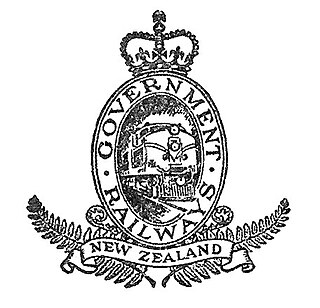
The New Zealand Railways Department, NZR or NZGR and often known as the "Railways", was a government department charged with owning and maintaining New Zealand's railway infrastructure and operating the railway system. The Department was created in 1880 and was corporatised on 1 April 1982 into the New Zealand Railways Corporation. Originally, railway construction and operation took place under the auspices of the former provincial governments and some private railways, before all of the provincial operations came under the central Public Works Department. The role of operating the rail network was subsequently separated from that of the network's construction. From 1895 to 1993 there was a responsible Minister, the Minister of Railways. He was often also the Minister of Public Works.
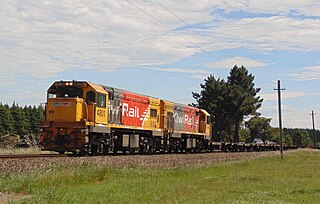
The New Zealand DC class locomotive is a type of diesel-electric mainline locomotive on the New Zealand rail network, operated by KiwiRail on freight trains, and formerly on long-distance passenger trains. The class was rebuilt from the DA class in the late 1970s and early 1980s, mainly in Australia. After the DA class, they were the most numerous class of diesel locomotive on New Zealand's railway network and remained numerically dominant until the mid-2010s when withdrawals began.
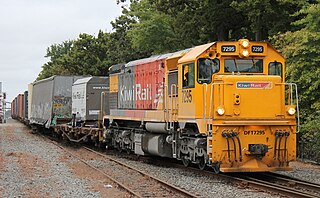
The New Zealand DF class locomotive of 1979 is a class of 30 Co-Co diesel-electric locomotives built by General Motors Diesel of Canada between 1979 and 1981. Between 1992 and 1997, all the locomotives were rebuilt as the DFT class, a turbocharged version of the DF.

The East Coast Main Trunk (ECMT) is a railway line in the North Island of New Zealand, originally running between Hamilton and Taneatua via Tauranga, connecting the Waikato with the Bay of Plenty. The ECMT now runs between Hamilton and Kawerau, with a branch line to Taneatua from the junction at Hawkens. The line is built to narrow gauge of 1,067 mm, the uniform gauge in New Zealand. It was known as the East Coast Main Trunk Railway until 2011, when the word "Railway" was dropped.
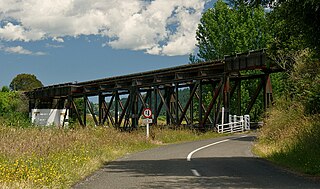
The Stratford–Okahukura Line (SOL) is a secondary railway line in the North Island of New Zealand, between the Marton - New Plymouth Line (MNPL) and the North Island Main Trunk (NIMT) Railway, with 15 intermediate stations. It is 144 km (89 mi) long through difficult country, with 24 tunnels, 91 bridges and a number of sections of 1 in 50 grade. Near Okahukura there is an unusual combined road-rail bridge over the Ongarue River, with the one-lane road carriageway below the single rail track. The line is not currently in service for rail traffic and is under a 30-year lease for a tourist venture. In July 2019 KiwiRail's CEO stated that reopening the line was a priority. Minister of Transport Michael Wood announced the government's 10-year plan for rail investment on 6 May 2021, which specifically stated that plans could include re-opening the Stratford to Okahukura line.

Palmerston North railway station is a main station on the North Island Main Trunk serving the city of Palmerston North in the Manawatū-Whanganui region of New Zealand.
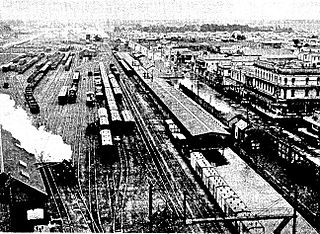
Palmerston North Central railway station was a station on the North Island Main Trunk in New Zealand and the Palmerston North–Gisborne Line. The station opened in 1876 and closed in 1963.

Taumarunui railway station is the main railway station in Taumarunui, New Zealand, serving the Northern Explorer service between Auckland and Wellington. Historically, it was an important intermediate stop with a refreshment room on the North Island Main Trunk line; the subject of the ballad "Taumarunui on the Main Trunk Line" by Peter Cape.
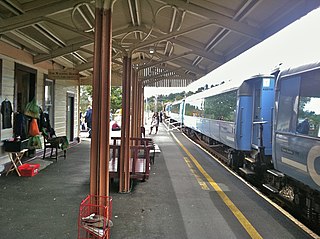
Ohakune railway station is a station on the North Island Main Trunk (NIMT), which serves the town of Ohakune in the Manawatū-Whanganui region of New Zealand. It is served by KiwiRail's Northern Explorer long distance train between Wellington and Auckland. It was called Ohakune Junction from 10 August 1926 until Raetihi Branch closed in 1968, to avoid confusion with Ohakune Town station on that branch. It was the second highest operating railway station in New Zealand, after National Park.

The Makatote Viaduct takes the North Island Main Trunk railway (NIMT) across the Makatote River. It is 335.7 km (208.6 mi) from Wellington, at the foot of Ruapehu, in northern Manawatū-Whanganui, between Erua and Pokaka.
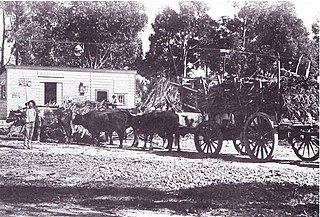
Te Kauwhata was a flag station on the North Island Main Trunk line, in the Waikato District of New Zealand, 54 mi (87 km) south of Auckland. It was 591.52 km (367.55 mi) north of Wellington, 3.32 km (2.06 mi) north of Rangiriri, 6.72 km (4.18 mi) south of Whangamarino and 12 m (39 ft) above sea level.
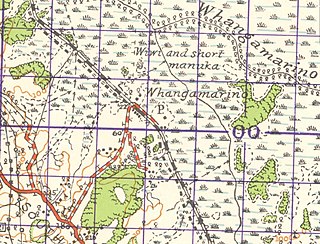
Whangamarino was a flag station on the North Island Main Trunk line, in the Waikato District of New Zealand, 49 mi (79 km) south of Auckland. It was 598.24 km (371.73 mi) north of Wellington, 6.19 km (3.85 mi) south of Amokura, 6.72 km (4.18 mi) north of Te Kauwhata and 7 m (23 ft) above sea level.

Horopito was a station on the North Island Main Trunk line, in the Ruapehu District of New Zealand. It served the small village of Horopito and lies just to the north of two of the five largest NIMT viaducts. It and Pokaka also lay to the south of Makatote Viaduct, the late completion of which held up opening of the station.


















